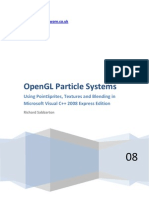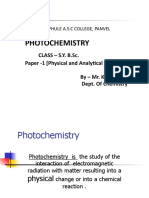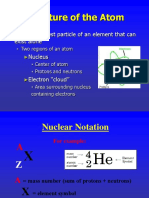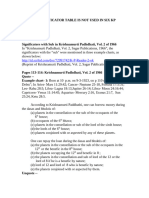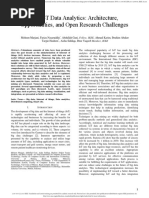15 Radio Activity
15 Radio Activity
Uploaded by
Hasmukh ShahCopyright:
Available Formats
15 Radio Activity
15 Radio Activity
Uploaded by
Hasmukh ShahCopyright
Available Formats
Share this document
Did you find this document useful?
Is this content inappropriate?
Copyright:
Available Formats
15 Radio Activity
15 Radio Activity
Uploaded by
Hasmukh ShahCopyright:
Available Formats
Chapter - 8
RADIO ACTIVITY
Introduction
In 1896, Henry Becquerel accidentally discovered that crystals of Uranium Salt emitted radiation similar to
X-rays.
These radiations :
(a) affected photographic plates (b) ionised gases. (c) were highly penetrating.
These radiations were called Becquerel Rays. Further studies revealed that there are many more heavy elements
which exhibit this emission property. In 1898, Marie Curie and Pierre Curie discovered two more elements Polonium
and Radium which are a million times active than Uranium.
The emission of these Becquerel Rays (high energy radiation) is a spontaneous nuclear phenomenon and is
unaffected by external agencies like temperature, pressure etc. Experiments show that atoms of radio active
substances disintegrate. All the elements from atomic number 83 to 92 are found to be radioactive.
For a radio active nucleus
N
1
Z
>
N No. of neutrons Z No. of protons
1. What is radioactivity ? Explain the nature of radioactive rays.
The phenomenon of spontaneous disintegration of heavy nuclei with the emission of certain radiations is
called Radioactivity. The radioactivity found in naturally occuring elements is known as Natural
Radioactivity. The radiations emitted during radioactivity are called radioactive rays (Becquerel Rays).
When these radiations are subjected to an electric field produced by two metal plates, one type of radiation is
bent slightly towards the negative plate, another strongly towards the positive plate and the third one is not affected.
These are called o | , and rays respectively
.
A strong magnetic field directed inwards produce the same effect as well. Experiments show that
o- particle in a helium nucleus
2
4
He consists of two protons and two neutrons and hence is positively charged
with a total charge of +2e. While | particles are electrons carrying a negative charge (-e) rays are electrically
neutral and are electromagnetic radiations of wave length 0 01 01 . . A to A
0 0
.
NOTE :
1. The usual trajectory of Becquerel rays is straight.
2. These three radiations are not emitted simultaneously.
3. All radioactive elements emit either o rays or | rays but never both and this is followed by rays.
2. State and Explain Soddys group displacement law
1. Radio active nucleus emits only one particle at a time, namely either an o-particle or | particle never both.
This is followed by emission -rays.
2. a) When an o - particle is emitted by a radio active nucleus, the new element has its atomic number
decreased by 2 and the mass number decreased by 4 than that of the parent element.
Example :
92
238
90
234
2
4
U Th He
o
+
decay
or in general
Z
A
Z
A
X Y He +
2
4
2
4
The new element so formed falls in a group two columns to the left of parent element in the periodic
table.
(b) When a radio active nucleus emits a | - particle, the new element has its atomic number increased by
1 but mass number remains constant.
Example :
90
234
91
234
1
0
Th Pa e
|
+
decay
or in general
Z
A
Z
A
X Y e
|
+
+
decay
1 1
0
The new element so formed falls in a group, one column to the right of the parent element in the periodic
table.
During | emission, parent and daughter products are ISOBARS.
(c) When a - ray is emitted by the radio active nucleus neither the mass number nor the atomic number
changes but there is only a loss of energy.
Note : If the daughter element is also radioactive, disintegration or emission continues till a stable element (usually
lead) is reached i.e. (atomic number 82 is reached).
3. State the law of radioactive decay (law of disintegration). Obtain an expression for the number of
atoms present at any instant of time.
The law states that the number of atoms disintegrating per second is proportional to the number of
atoms present in the element at that instant of time.
Let N
0
be the number of atoms present at t = 0 in a radioactive sample. Let N be the number of atoms that
remain in the sample at any instant of time `t. II dN atoms disintegrate in a time dt.
Then, according to the decay lay :
=
dN
dt
N
dN
dt
N or ..............( ) 1
Where is called the decay constant or disintegration constant of the element and the -ve sign indicates that
the number of atoms decrease with time.
From equation (1)
dN
N
dt =
Integrating both sides
log
e
N t c = + . ................. (2) Where c is a constant of integration.
At t N N = = 0
0
, substituting this in equation (2), we get
log
e
N c
0
=
Substituting for c in equation (2) again
log log
log log
. . log
e e
e e
e
t
t
N t N
N N t
i e
N
N
t
N
N
e
N N e
= +
=
=
=
=
0
0
0
0
0
or
This equation shows that the number of atoms in a radioactive sample decays or decrease exponentially
with time and hence its mass as well.
NOTE :
1. The factor dN/dt is called the rate of disintegration or activity or strength of the substance.
2. Activity is expressed in a unit called Curie (Ci) and Rutherford (Rf)
(i) 1 curie is the activity of 1 gm of radium
1 Curie = 3 7 10
10
. disintegrations/sec.
(ii) 1 Rutherford = 10
6
disintegration / sec.
( ) 1 Rf 1 dis / sec 1 Bequeril Bq = = S. I. Units.
Specific activity is the activity of 1gm of a substance.
4. Define the terms disintegration constant, half life and mean life of a radioactive element.
(a) Disintegration or decay constant
By decay law
dN
dt
N
dN dt
N
=
=
/
Thus the decay constant of a radioactive element is the ratio of the rate of disintegration to the number
of atoms present in it at that instant of time.
(b) Half Life (T)
The half life of a radioactive element is defined as the time taken by half the number of original atoms to
disintegrate or half the original mass to disintegrate.
T =
0 693 .
(c) Average Life or Mean Life T
av
Average life or mean life of a radioactive element is the average time for which the atoms of a radioactive
element exist.
T
av
=
Sum of the lives of all the atoms
Number of atoms
It can be shown that,
T
av
=
1
but
=
0 693 .
T
=
= =
T
T
T
T
T T
av
av av
1
0 693
0 693
0 693
. /
.
. or or
Note : T T
av
> i.e. average life of a radio active element is greater than its half life.
5. Define Half life and deduce an expression for the same.
The half life of a radioactive element is defined as the time taken for exactly half the number or half the
mass of the element to disintegrate. It is denoted by T.
Let N be the original number of atoms at t = 0.
Let N be the number of atoms present at any instant of time `t.
We know that :
0
=
t
N N e
When
t T N
N
= = ,
0
2
0
0
2
N
N eT =
i.e.
1 1 1
or
2 2
2
T
T
T
e
e
e
= =
=
Taking logarithms to the base e
log log
log
e
T
e
e
e
T
=
=
2
2
10
2.303 log 2 2.303 0.3010
0.693
0.693
= =
=
=
or T
T
T
Thus half life is inversely proportional to the decay constant.
Corollary
At
At
At
At
At
t N N
N
t T N
N N
t T N
N N
t T N
N N
t nT N
N N
n n
= = =
= = =
= =
=
= =
=
= =
0
2
2 2
2
1
2 2 2
3
1
2 2 2
1
2 2 2
0
0
0
0 0
1
0 0
2
0
2
0
3
0
1
0
,
,
,
,
. . . . . . . . .
. . . . . . . . .
. . . . . . . . .
,
Thus after n half lives, the number of atoms left in the sample =
N
n
0
2
Number of atoms decayed in n half lives =
0 0
1
1
2
(
=
(
n
N N N
6. Write the radioactive law in terms of mass of the sample.
As N N e
t
=
0
for a radioactive substance and as the mass of the sample is proportional to the number oI
nuclei or atoms present in it at any instant of time. M N
0 0
and
M N
where M
0
is the original mass and N
0
original number of atoms. M mass at any instant of time and N the corresponding number of atoms at that instant of
time t.
=
M M e
t
0
and after n half lives mass of the sample left =
M
n
0
2
Also
0
=
t
A A e and after n half lives the activity of the sample
0
2
=
n
A
A
NOTE :
Significance of decay constant
N N e t T T
t
m m
= = =
0
1
if then
= =
=
N
N
e
e
N
e
N
0
1
0
1
1
Thus decay constant is numerically equal to the reciprocal of the time required during which the number
of atoms in a sample reduce to
1
e
times the initial or original number..
e
e
=
=
2 718
1
0 368
.
.
It is also reciprocal of the time required in which the number of atoms in a sample reduce to
0.368 (36.8%) times the original number.
(a) in one half life 50% remain 50% disintegrate
(b) in one mean life 37% remain (approx.) 63% disintegrate (approx.)
7. Write a note on Artificial or Induced Radioactivity.
The phenomenon or process by which an element can be made radioactive to emit radiation is called artificial
radioactivity and the process of converting one element into another is called artificial transmutation.
It was discovered by Irene Curie Joliot and Fredrick Joliot in 1934. When an element like Aluminium, Boron,
etc. are bombarded by o - particles, they continue to emit radiations even after the removal of the source of o - rays.
The bombarded substances become unstable and disintegrate emitting radiation. These radiations consisted of particles
having a positive charge and mass equal to that of an electron. These are known as positrons which is explained as
follows:
When Boron is bombarded with o particle an unstable nucleus of nitrogen is formed. This disintegrates
spontaneously with a half life of 10.1 mins. into a stable isotope of carbon emitting a positron. Detailed as hereunder
in the form of an equation.
5
10
2
4
7
13
0
1
7
13
6
13
1
0
B He N n
N C e
+ +
+ positron
The nitrogen formed in the above case is known as radio nitrogen. In a similar way radio sodium, radio cobalt,
radio phosphorous are produced. These find extensive applications in the fields of medicine, science and agriculture.
Note : Transmutation is a process of converting one element into another by artificial means. Generally it is
done by bombarding the nucleus to be converted with elementary particles like Neutrons, Protons, Deuterons,
o-particle etc. Neutrons are most preffered as they can enter the nucleus without repulsion
8. Write or mention the applications of radioactive radiations.
(a) Radioactive nuclides emitting o | or particles are used in the generation of Electric power by thermo-electric
conversion.
(b) They are used as a source of heat energy to heat propellent gases in low thrust rockets.
(c) rays replace x-rays in dentistry for photographing the jaws.
(d) rays are used in the paper industry to check the thickness of the paper thickness gauging.
(e) rays from cobalt-60 are used as sterilising agents in hospitals. a-rays of Co
60
is used in treating cancer..
(f) rays are used by industrial radiographers to detect minor and minute flaws in the machinery..
(g) C-14 a radioactive carbon isotope is used in archaelogical dating to determine the age of rocks.
(h) rays are utilised in the food industry as disinfectant.
(i) Self luminous or radiant paints are manufactured with the help of radioactive nuclides emitting o particles.
(j) rays are used in the cancer therapy..
(k) Artificial radioactivity is used in the manufacturing of fertilisers.
(l) To photogaph brain tumor, Hg
197
radioisotope is used.
(m) The activity of thyroid gland can be determined by monitoring its iodine uptake using radioactive I
131
.
9. Compare and contrast the three types of radioactive radiations.
PROPERTY
o RAYS | RAYS RAYS
1. Visibility and All the three are invisible but can be detected by the fluroscence they cause on fluroscent
detection screen (Zns coated screen)
2. Nature Particles Particles Radiations
Beam of Helium nuclei Beam of electron Electromagnetic in nature
2
4
He
2 Protons + 2 Neutrons
3. Charge Positive + 2 e Negative -e Uncharged radiation of wave
+ 2 16 10
19
. C
16 10
19
. C
length range
0 01 01
0 0
. . A A to
4. Mass
4 4 1 66 10
27
Amu Kg =
. .
Negligible Mass =
1
1840
Amu
Rest mass is zero.
5. Deflection by Get deflected towards Get deflected towards Not deflected
Electric field -ve plate. +ve plate.
6. Deflection by Get deflected accord- Get deflected accord- Not deflected
Magnetic field ing to Flemings leIt ing to Flemings leIt
hand rule hand rule
7. Velocity 1 10
7
.45 / sec. m to 2 3 10
8
. / sec. m to
3 10
8
m / sec.
2 3 10
7
. / sec. m 2 8 10
8
. / sec. m
depending upon the source.
8. Energy Smallest Intermediate Highest due to high
frequency.
9. Ionising power Highest, 100 time | Intermediate (1/100)th Lowest (1/100)th of |
and 10,000 times of o, 100 times .
1
10 000 ,
of o.
10. Penetrating Lowest, can be Intermediate can Highest can penetrate
power stopped by a sheet penetrate thin metal through iron plates of
of ordinary writing foils can be stopped thickness 30 cm.
paper by 5mm Al foil.
11. When exposed Affects the plate Affects the plate Affects the plate
photographic Produce heating | particles (elec-do Destroys living tissues.
plate. effect materials like not exist in the nucleus. Produce photoelectric
glass, crystals etc. when They are formed at the effect and compton effect,
exposed o rays change moment of emission due can be reflected, refracted,
their colour and may to transformation of just like light. Shows inter-
become brittle. Neutrons into protons ference and diffraction
and electrons).
12. Path Short, thick, straight Thin, long, curved disjointed
Note : GEIGER MULLER counter is used to detect o & |.
2. WILSON CLOUD CHAMBER is used for detecting o, |. and particles and to determine their paths, range and energy.
-oo0oo-
You might also like
- Solution ManualDocument100 pagesSolution ManualmichaelNo ratings yet
- 2922radioactivity Summary Cheat Sheet..Aidan MatthewsDocument3 pages2922radioactivity Summary Cheat Sheet..Aidan MatthewsSyed Mairaj Ul HaqNo ratings yet
- OpenGL - Particle System Tutorial - Blending - Point SpritesDocument20 pagesOpenGL - Particle System Tutorial - Blending - Point SpritesPaulo GarciaNo ratings yet
- Atoms & Nuclei: Rutherford's Alpha Scattering ExperimentDocument9 pagesAtoms & Nuclei: Rutherford's Alpha Scattering ExperimentNathanianNo ratings yet
- Atomic NucleusDocument15 pagesAtomic Nucleussreenivas1990100% (1)
- Physics 08 NuclearDocument32 pagesPhysics 08 NuclearPiotr NowakNo ratings yet
- Notes - Radioactivity and Nuclear EnergyDocument28 pagesNotes - Radioactivity and Nuclear EnergyUlwindass Victor Gorge100% (1)
- Radioacitvity PDFDocument14 pagesRadioacitvity PDFArjun RavalNo ratings yet
- Nuclear Physics: Basic Properties of NucleusDocument17 pagesNuclear Physics: Basic Properties of NucleusSK. NAFISH SADIQUE AYON 1903043No ratings yet
- 1 - Nuclear Chemistry PDFDocument51 pages1 - Nuclear Chemistry PDFSangga Buana Komara100% (1)
- Phys 490Document346 pagesPhys 490realityonNo ratings yet
- Radioactive Decay MathematicalDocument3 pagesRadioactive Decay MathematicalJono WojciechowskiNo ratings yet
- Outline Radioactive Decay KineticsDocument53 pagesOutline Radioactive Decay KineticsDea AlabarderoNo ratings yet
- Radioactive Decay: © 2006, K.E. Holbert Page 1 of 9Document9 pagesRadioactive Decay: © 2006, K.E. Holbert Page 1 of 9ucing_33No ratings yet
- The Atomic NucleusDocument85 pagesThe Atomic NucleusARUNA RESHMINo ratings yet
- ES Notes - GTUDocument104 pagesES Notes - GTUPratik GadhiyaNo ratings yet
- Nuclear Decay (Alpha, Beta and Gamma)Document17 pagesNuclear Decay (Alpha, Beta and Gamma)Parahat.Tajov100% (1)
- PhysicsDocument64 pagesPhysicsChandra SekharNo ratings yet
- Chemistry NotesDocument24 pagesChemistry NotesTaylor HuangNo ratings yet
- CH 21 WL Photon Dosimetry Concepts and CalculationsDocument47 pagesCH 21 WL Photon Dosimetry Concepts and Calculationsoomganapathi100% (1)
- Lecture Notes - Oscillations and WavesDocument55 pagesLecture Notes - Oscillations and WavesRashmikaNo ratings yet
- Modern Physics SolutionDocument28 pagesModern Physics Solutionskadogg2250% (2)
- A Molecular Approach Chapter 07Document99 pagesA Molecular Approach Chapter 07StephenNo ratings yet
- Treatment Planniinc IDocument6 pagesTreatment Planniinc IAbdul Al-FattahNo ratings yet
- Diode Laser SetupDocument16 pagesDiode Laser SetupBodhaditya SantraNo ratings yet
- Syllabus PDFDocument253 pagesSyllabus PDFVivek KumarNo ratings yet
- Important Formula For Numerical:-: 4 Einstein S Mass Energy Equivalence Relation Is E MCDocument28 pagesImportant Formula For Numerical:-: 4 Einstein S Mass Energy Equivalence Relation Is E MCdhirendrasisodiaNo ratings yet
- Ion Protection of The Patient in Diagnostic Radiology and Nuclear Medicine Vol 57 Proceedings of A Workshop Held in Grado Italy September 29 To October 1 1993Document536 pagesIon Protection of The Patient in Diagnostic Radiology and Nuclear Medicine Vol 57 Proceedings of A Workshop Held in Grado Italy September 29 To October 1 1993Zoran MirkovNo ratings yet
- PhotochemistryDocument29 pagesPhotochemistryArangaNo ratings yet
- Raphex Answers 2010Document15 pagesRaphex Answers 2010Ant MenNo ratings yet
- Radioactive Decay & Half-Life Calculation: Presenters: Damion Lawrence and Michael WardDocument39 pagesRadioactive Decay & Half-Life Calculation: Presenters: Damion Lawrence and Michael WardKimonie BellanfanteNo ratings yet
- CRHPDocument4,229 pagesCRHPbcurrier10100% (1)
- Nuclear Physics: James T. Shipman Jerry D. Wilson Charles A. Higgins, Jr. Omar TorresDocument122 pagesNuclear Physics: James T. Shipman Jerry D. Wilson Charles A. Higgins, Jr. Omar Torrescarl jason talanNo ratings yet
- 15° Wedge Transmission Factor CalculationDocument10 pages15° Wedge Transmission Factor Calculationapi-302707617No ratings yet
- IITMFRPDocument606 pagesIITMFRPSouba GiridharNo ratings yet
- Physics Notes - Medical Physics 2Document18 pagesPhysics Notes - Medical Physics 2Camson HuynhNo ratings yet
- Atomic Physics The Nuclear Atom and RadioactivityDocument44 pagesAtomic Physics The Nuclear Atom and RadioactivityAli Ahmad AliNo ratings yet
- Iit KGP Ar 18-19 - IitkgpDocument248 pagesIit KGP Ar 18-19 - IitkgpRoopam GoenkaNo ratings yet
- RadioactivityDocument12 pagesRadioactivityAya WalidNo ratings yet
- Supplement: Workshop On Radiation Dosimetry: Basic Technologies, Medical Applications, Environmental ApplicationsDocument86 pagesSupplement: Workshop On Radiation Dosimetry: Basic Technologies, Medical Applications, Environmental ApplicationsLiviu CraciunNo ratings yet
- Elements of Radiobiology and Radioprotection: Dr. A. Iftime, Dr. E. KatonaDocument12 pagesElements of Radiobiology and Radioprotection: Dr. A. Iftime, Dr. E. KatonaAlexandra StoikNo ratings yet
- Radio PharmacologyDocument32 pagesRadio PharmacologyKaise GuerreroNo ratings yet
- Nuclear TechnologyDocument18 pagesNuclear Technologysipun acharyaNo ratings yet
- Curriculum Physics RadiologyDocument156 pagesCurriculum Physics Radiologydrzalie70No ratings yet
- Neutron SourcesDocument64 pagesNeutron SourcesJenodi100% (1)
- (UV Vis) SpectrosDocument4 pages(UV Vis) SpectrosGarion Charles0% (1)
- Wave Notes 3 - Reflection1Document5 pagesWave Notes 3 - Reflection1Syed Mairaj Ul HaqNo ratings yet
- 04Document25 pages04Sushil KoiralaNo ratings yet
- Chapter 5 Radioactivity: Writing Nuclear Reaction EquationDocument2 pagesChapter 5 Radioactivity: Writing Nuclear Reaction Equationleelee1127100% (1)
- P1153 1Document500 pagesP1153 1jiar001No ratings yet
- Modern Physics Solution FsuDocument7 pagesModern Physics Solution Fsurinzzz333100% (1)
- Topic 7.2 - Nuclear Reactions - TeacherDocument43 pagesTopic 7.2 - Nuclear Reactions - TeacherNoman Qureshi100% (1)
- Introduction To Nuclear Medicine: Sania Rahim PGY 4 BCM C/o 2008Document28 pagesIntroduction To Nuclear Medicine: Sania Rahim PGY 4 BCM C/o 2008asfadsi23No ratings yet
- CHEM 100 Nuclear ChemistryDocument2 pagesCHEM 100 Nuclear ChemistryDane デーン MalilayNo ratings yet
- Lecture 2Document53 pagesLecture 2stopNo ratings yet
- Biological and Environmental Physics: Dr. D. J. Miller Room 535 (Kelvin Building) D.miller@physics - Gla.ac - UkDocument81 pagesBiological and Environmental Physics: Dr. D. J. Miller Room 535 (Kelvin Building) D.miller@physics - Gla.ac - UkBala GanapathyNo ratings yet
- MRI Lecture NotesDocument33 pagesMRI Lecture NotesArungoud PoshalaNo ratings yet
- UV Visible SpectrosDocument8 pagesUV Visible Spectrosbarani_autNo ratings yet
- X-Ray Absorption and X-Ray Emission Spectroscopy: Theory and ApplicationsFrom EverandX-Ray Absorption and X-Ray Emission Spectroscopy: Theory and ApplicationsNo ratings yet
- Cool Experiments on Static Electricity - Science Book of Experiments | Children's Electricity BooksFrom EverandCool Experiments on Static Electricity - Science Book of Experiments | Children's Electricity BooksNo ratings yet
- Designing A Training ManualDocument5 pagesDesigning A Training Manualmaureen50% (2)
- Guia TeraSpanDocument73 pagesGuia TeraSpanTim Robles MartínezNo ratings yet
- 04 - Sanjana Bhandiwad - Assignment 2 - Basement ExcavationDocument27 pages04 - Sanjana Bhandiwad - Assignment 2 - Basement Excavation04BHANDIWAD SANJANA100% (1)
- Grade 11 Excel Paper 4Document3 pagesGrade 11 Excel Paper 4ggsilvaboy7No ratings yet
- The Filipino Chinese in World LiteratureDocument3 pagesThe Filipino Chinese in World Literaturejikka badilloNo ratings yet
- Understanding Product Environmental Footprint and-KJNA31236ENNDocument39 pagesUnderstanding Product Environmental Footprint and-KJNA31236ENNKovács Viktória BarbaraNo ratings yet
- HRIS Assignment PDFDocument2 pagesHRIS Assignment PDFAhmed MAHAREEKNo ratings yet
- An Introduction To Spanish For Health Care Workers Communication and Culture, 3e (2010)Document398 pagesAn Introduction To Spanish For Health Care Workers Communication and Culture, 3e (2010)johngaltjeep100% (5)
- The Update of The Phylogenetic Structure of Q1b Haplogroup Based On Full Y-Chromosome SequencingDocument9 pagesThe Update of The Phylogenetic Structure of Q1b Haplogroup Based On Full Y-Chromosome SequencingVladimir GurianovNo ratings yet
- Technical Data Sheet: Speaker Cable Model: CBBR0411Document1 pageTechnical Data Sheet: Speaker Cable Model: CBBR0411Adrian BirdeaNo ratings yet
- Annexure - IX - To - Send 16102024Document6 pagesAnnexure - IX - To - Send 16102024s.basuNo ratings yet
- Six Fold SignificatorsDocument6 pagesSix Fold SignificatorsrajeevsonaliNo ratings yet
- STE SD - PICE Presentation - Javier Lopez Gimenez2Document45 pagesSTE SD - PICE Presentation - Javier Lopez Gimenez2Lawrence Kevin FrencillanoNo ratings yet
- Allantoin Soothing Effect 2Document8 pagesAllantoin Soothing Effect 2Valentina CarreroNo ratings yet
- Big IoT Data Analytics - Architecture, Opportunities, and Open Research ChallengesDocument17 pagesBig IoT Data Analytics - Architecture, Opportunities, and Open Research Challengesazam_rasheedNo ratings yet
- Design of Concrete Bridges: Praveen NagarajanDocument18 pagesDesign of Concrete Bridges: Praveen NagarajanSSNo ratings yet
- Welding ManualDocument32 pagesWelding ManualHammondMachineNo ratings yet
- Course Description 100 LEVEL EPM 111: Principles of Environmental Planning and ManagementDocument8 pagesCourse Description 100 LEVEL EPM 111: Principles of Environmental Planning and ManagementAlvinTiteNo ratings yet
- 2019 Basketball Court EstimateDocument2 pages2019 Basketball Court EstimateJuryl ZacariasNo ratings yet
- UNIT 1. MY NEW SCHOOL - GLOBAL 6-KEYS-2024Document9 pagesUNIT 1. MY NEW SCHOOL - GLOBAL 6-KEYS-2024thanhhuyen84bmtNo ratings yet
- A Manual For Writers of Research Papers Theses and Dissertations PDF DownloadDocument8 pagesA Manual For Writers of Research Papers Theses and Dissertations PDF DownloadWriteMyPaperForMeIn3HoursMilwaukeeNo ratings yet
- Spartan TapeDocument41 pagesSpartan TapeamyNo ratings yet
- CHAPTER3 Water Flow MeasurementsDocument8 pagesCHAPTER3 Water Flow MeasurementsMel CapalunganNo ratings yet
- Luminaries InstructionsDocument2 pagesLuminaries InstructionslupepatchNo ratings yet
- Catalogo Ansul ExtintoresDocument2 pagesCatalogo Ansul Extintoresgabrielmatta1No ratings yet
- PPG - Module 2 - 2ND Sem - 2ND Quarter - Grade 11 - Humss Bonifacio-Agoncillo - MR - Paombong - MRS CuencaDocument12 pagesPPG - Module 2 - 2ND Sem - 2ND Quarter - Grade 11 - Humss Bonifacio-Agoncillo - MR - Paombong - MRS CuencaArnold Paombong100% (1)
- Samsung EcobubbleDocument840 pagesSamsung EcobubbleAlinaNo ratings yet
- Max Dupain ModernistDocument32 pagesMax Dupain ModernistFrancisco FernandezNo ratings yet
- First Long Test in Mathematics 8Document3 pagesFirst Long Test in Mathematics 8Raquel YayaNo ratings yet


